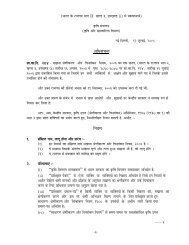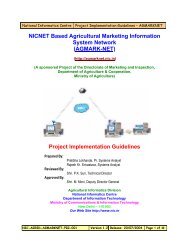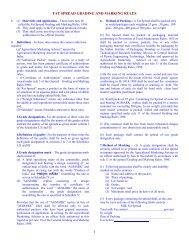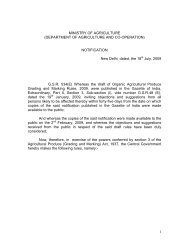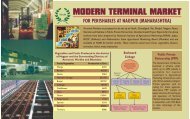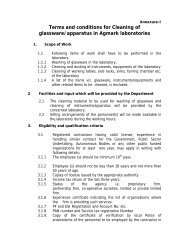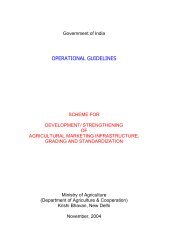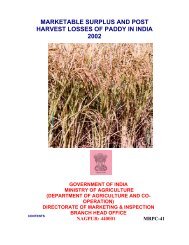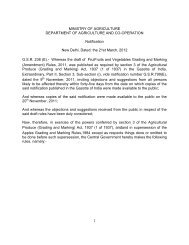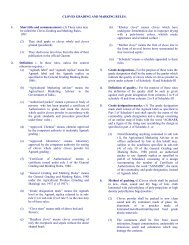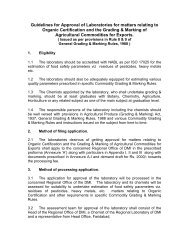Post-harvest profile of red gram - Agmarknet
Post-harvest profile of red gram - Agmarknet
Post-harvest profile of red gram - Agmarknet
You also want an ePaper? Increase the reach of your titles
YUMPU automatically turns print PDFs into web optimized ePapers that Google loves.
Forward contracts are broadly <strong>of</strong> two types:a) Specific delivery contracts: Specific delivery contracts are essentially merchandisingcontracts, which enable producers and consumers <strong>of</strong> commodities to market their produce andcover their requirements respectively. These contracts are generally negotiated directlybetween parties depending on availability and requirement <strong>of</strong> produce. During negotiation,terms <strong>of</strong> quality, quantity, price, period <strong>of</strong> delivery, place <strong>of</strong> delivery, payment term, etc. areincorporated in the contracts. Specific delivery contracts are <strong>of</strong> two types:i) Transferable specific delivery contracts (T.S.D.).ii) Non-transferable specific delivery contracts (NTSD).In the TSD contracts, transfer <strong>of</strong> the rights or obligations under the contract is permittedwhile in NTSD it is not permitted.b) Other than specific delivery contracts: Though this contract has not been specificallydefined under the act, these are called as ‘future contracts’. Futures contracts are forwardcontracts other than specific delivery contracts. These contracts are usually ente<strong>red</strong> into underthe auspices <strong>of</strong> an Exchange or Association. In the futures contracts, the quality and quantity<strong>of</strong> commodity, the time <strong>of</strong> maturity <strong>of</strong> contract, place <strong>of</strong> delivery etc. are all standardised andcontracting parties have to negotiate only the rate at which contract is ente<strong>red</strong> into.Benefits:Futures contracts perform two important functions i) Price discovery and ii) Price riskmanagement. It is useful to all segments <strong>of</strong> economy.Producers:Traders/Exporters:Millers/Consumers:The other benefits <strong>of</strong> future trading are-It is useful to the producer because they can get idea <strong>of</strong> price likelyto prevail at a future point <strong>of</strong> time and, therefore, can decide timeand planning <strong>of</strong> production that suits them.The future trading is very useful to the traders/exporters as itprovides an advance indication <strong>of</strong> the price likely to prevail. Thishelps the traders/exporters in quoting a realistic price and, thereby,secure trading/export contract in a competitive market.Futures trading enables the millers/consumers to get an idea <strong>of</strong> theprice at which the commodity would be available at a future point <strong>of</strong>time.i) Price stabilization: In times <strong>of</strong> violent fluctuations, futures trading <strong>red</strong>uces the pricevariations.ii) Competition:Futures trading encourages competition and provides competitiveprice to farmers, millers or traders.iii) Supply and demand: It ensures a balance in demand and supply position throughout theyear.iv) Integration <strong>of</strong> price: Futures trading promotes an integrated price structure throughoutthe country.48




